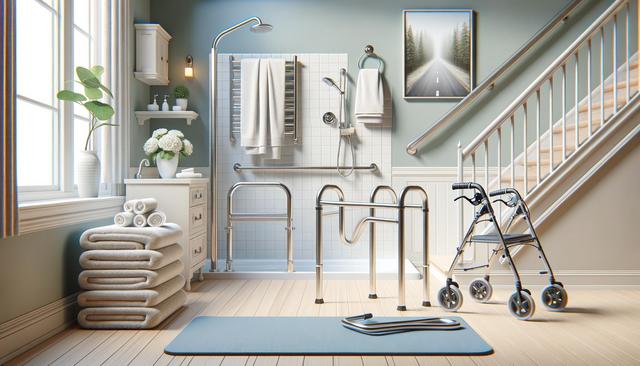Top Fall Prevention Products for Seniors: A Complete Guide to Staying Safe
This comprehensive guide covers the top fall prevention products for seniors, helping to create a safer home environment. Learn about tools such as grab bars, slip-resistant mats, and wearable devices that can reduce the risk of falls and promote independence.

Understanding the Importance of Fall Prevention
Falls are one of the leading causes of injury among older adults, often leading to serious health consequences and a loss of independence. As people age, changes in balance, mobility, and vision can increase the risk of falling. Fortunately, a variety of fall prevention products are available to help reduce these risks and provide seniors with greater confidence in their daily routines. By incorporating the right safety tools and making small adjustments to the home environment, many falls can be prevented before they happen. This proactive approach is not just about avoiding injury—it’s about preserving independence and improving quality of life.
Fall prevention starts with awareness and planning. Identifying potential hazards in the home, such as loose rugs, poor lighting, and uneven flooring, is an essential first step. From there, implementing solutions such as safety equipment, mobility aids, and monitoring devices can create a more secure living space for seniors.
Essential Bathroom Safety Tools
The bathroom is one of the most common areas where falls occur, due to slippery surfaces and limited support. Equipping this space with practical safety products can significantly reduce the risk of accidents. Some widely recommended fall prevention items for the bathroom include:
- Grab bars: Installed near toilets, showers, and bathtubs, these provide sturdy support for standing and sitting.
- Non-slip bath mats: Placed inside and outside the tub or shower to prevent slipping on wet surfaces.
- Raised toilet seats: These reduce the strain of bending and make it easier to sit and stand.
- Shower chairs: Allow users to sit while bathing, offering both safety and comfort.
Each of these items addresses a specific need and can be customized to suit the individual’s mobility level. When selecting these products, look for designs that are easy to install, durable, and accommodate weight and space requirements.
Improving Mobility With Assistive Devices
For seniors with mobility challenges, having the right assistive devices can significantly enhance movement and reduce fall risk. These tools provide stability and help prevent fatigue, which is a common contributor to falls. Some commonly used mobility aids include:
- Canes: Provide extra support for walking and are available in different styles, such as quad canes for greater balance.
- Walkers and rollators: Offer enhanced support and often come with built-in seats for resting.
- Transfer aids: Help with moving safely between beds, chairs, and wheelchairs.
Using these devices correctly is key. Seniors and caregivers should receive guidance from healthcare providers or physical therapists to ensure proper fit and use. Some modern mobility aids even come equipped with features like brakes, baskets, and ergonomic handles, which add convenience and safety.
Wearable Technology and Monitoring Systems
Technology can play a significant role in fall prevention and emergency response. Wearable devices and home monitoring systems are valuable tools for seniors who live alone or have medical conditions that increase their fall risk. These devices can detect falls, alert caregivers, and even monitor movement patterns to predict potential issues. Useful options include:
- Medical alert systems: Often worn as pendants or wristbands, these allow users to call for help quickly in the event of a fall.
- Fall detection sensors: Some devices automatically detect a fall and send an alert without needing manual activation.
- Smart home monitoring: Systems with motion detectors can track activity and notify caregivers of unusual patterns.
These solutions provide peace of mind to both seniors and their loved ones. While not a substitute for physical safety measures, wearable tech adds a layer of protection that can be crucial in emergencies.
Creating a Safer Home Environment
In addition to specific products, modifying the home environment is a fundamental aspect of fall prevention. Many hazards can be eliminated with simple adjustments that improve accessibility and visibility. Consider the following home safety improvements:
- Improved lighting: Install brighter bulbs and nightlights in hallways, bathrooms, and stairways.
- Decluttering: Keep floors clear of cords, rugs, and furniture that may obstruct pathways.
- Handrails on stairs: Ensure both sides of staircases have secure, easy-to-grip railings.
- Flooring updates: Replace slippery or uneven flooring with slip-resistant materials.
These changes not only reduce the risk of falls but also create a more comfortable and manageable living space. It’s a good idea to perform regular safety checks and make adjustments as needed, especially when health conditions or mobility levels change.
Conclusion: Supporting Independence Through Safety
Fall prevention is a crucial aspect of aging safely and comfortably at home. By integrating the right combination of products—from grab bars and mobility aids to wearable alert systems—seniors can maintain their independence while reducing their risk of injury. Creating a safer environment goes beyond buying devices; it involves thoughtful planning, regular assessments, and sometimes professional guidance. Whether you’re a senior looking to improve your own safety or a caregiver supporting a loved one, investing in fall prevention tools is a meaningful step toward preserving quality of life and peace of mind.